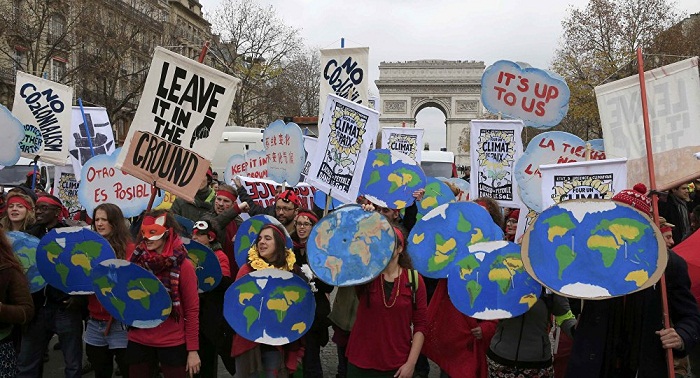The World Meteorological Organization (WMO) report, published on Monday at the global climate summit in Morocco, found the global temperature in 2016 is running 1.2C above pre-industrial levels. This is perilously close to to the 1.5C target included as an aim of the Paris climate agreement last December.
The El Niño weather phenomenon helped push temperatures even higher in early 2016 but the global warming caused by the greenhouse gas emissions from human activities remains the strongest factor.
“Another year. Another record,” said WMO secretary-general, Petteri Taalas. “The extra heat from the powerful El Niño event has disappeared. The heat from global warming will continue.”
“Because of climate change, the occurrence and impact of extreme events has risen,” he said. “‘Once in a generation’ heatwaves and flooding are becoming more regular.”
The WMO said human-induced global warming had contributed to at least half the extreme weather events studied in recent years, with the risk of extreme heat increasing by 10 times in some cases.
“It is almost as if mother nature is making a statement,” said climate scientist Michael Mann, at Penn State University in the US. “Just as one of the planet’s two largest emitters of carbon has elected a climate change denier [Donald Trump] - who has threatened to pull out of the Paris accord - to the highest office, she reminds us that she has the final word.”
“Climate change is not like other issues that can be postponed from one year to the next,” he said. “The US and world are already behind; speed is of the essence, because climate change and its impacts are coming sooner and with greater ferocity than anticipated.”
The record-smashing heat led to searing heatwaves across the year: a new high of 42.7C was recorded in Pretoria, South Africa in January; Mae Hong Son in Thailand saw 44.6C on 28 April; Phalodi in India reached 51.0C in May and Mitribah in Kuwait recorded 54.0C in July. Parts of Arctic Russia also saw extreme warming - 6C to 7C above average
Arctic ice reached its equal second lowest extent in the satellite record in September while warm oceans saw coral mortality of up to 50% in parts of Australia’s Great Barrier Reef.
Extreme weather and climate related events have damaged farming and food security, affecting more than 60 million people, according to the UN Food and Agriculture Organization. The level of CO2 in the atmosphere has also broken records in 2016, with May seeing the highest monthly value yet - 407.7 ppm - at Mauna Loa, in Hawaii.
The forecast for 2017 is another very hot year, but probably not a record breaker.
“As the El Niño wanes, we don’t anticipate that 2017 will be another record-breaking year,” said Dr Peter Stott at the UK’s Met Office. “But 2017 is likely to be warmer than any year prior to the last two decades because of the underlying extent of [human-caused] warming due to the increasing atmospheric concentration of greenhouse gases.”
However, another analysis released at the UN summit in Morocco showed that global carbon emissions have barely grown in the last three years, following decades of strong growth. The main reason is China burning less coal.
Professor Corinne Le Quéré, at University of East Anglia in the UK, who led the analysis, said: “This third year of almost no growth in emissions is unprecedented at a time of strong economic growth. This is a great help for tackling climate change but it is not enough. Global emissions now need to decrease rapidly, not just stop growing.”
The WMO’s temperature analysis combines the three main records, from the Met Office, Nasa and the National Oceanic and Atmospheric Administration, and stretches back to 1880.
More about:
















































